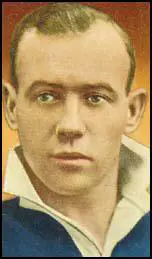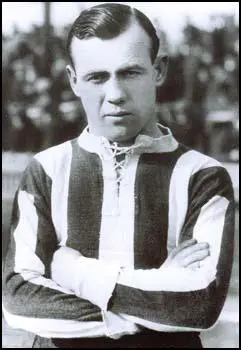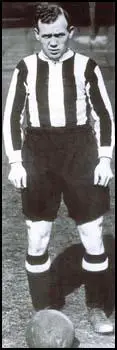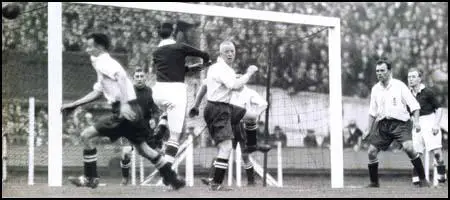Hughie Gallacher

Hughie Gallacher was born in Bellshill, Scotland, on the 2nd February 1903. He played local football for Tannockside Athletic and Hattonrigg Thistle in 1919. The following year he became a professional footballer when he signed for Queen of the South in the Scottish League.
Gallacher married at the age of 17 and his wife had two children but the couple separated by the time Gallacher was 20 years old.
In May 1921 Gallacher was transferred to Airdrieonians. Over the next four years he scored 91 goals in 111 games and was primarily responsible for Airdrieonians obtaining three Scottish League runner-up positions and a Scottish Cup while he was at the club.
Gallacher's form was so good he was selected to play for Scotland against Northern Ireland on 1st March 1924. The following season he won international caps against England and Wales. In his first four games for his country he scored five goals. It was the start of an amazing international career that resulted in him scoring 23 goals in only 20 games.
In 1925 Newcastle United paid Airdrieonians £6,500 for the services of Hughie Gallacher. It was a club record fee. Gallacher made an immediate impact and during his first season scored 23 goals in 19 games. The following season Newcastle won the First Division league title. Gallacher, who had been made captain of the side, scored 36 goals in 38 league games.
Newcastle United was less successful in the next three seasons but each year Gallacher was the clubs's top scorer: 1927-28 (21 in 32), 1928-29 (24 in 33) and 1929-30 (29 in 38). As Paul Joannou points out in The Black 'n' White Alphabet: "Hughie Gallacher is considered by many to be the greatest centre-forward of all time. Although a mere 5' 5", he was a handful for any defence possessing awesome strike power. Hughie could shoot with either foot, dribble with the ball, head, tackle, forage and also frequently lose his control on the field. A record of netting a formidable total of 463 goals in 624 senior matches speaks for itself, while Gallacher is United's most potent attacker of all time with a strike-rate of over 82% in his 174 outings."


Gallacher continued to play well for Scotland. He scored a hat-trick playing for his country against Northern Ireland on 27 February 1926. He was also a member of the Scotland side that thrashed England 5-1 at Wembley on 31st March 1928. The following year he scored all four goals in Scotland's 4-2 victory over Northern Ireland.
Gallacher was also often in dispute with the management of Newcastle United. He was often in trouble with referees and after one incident was suspended for two months. Gallacher was a heavy drinker and became involved with the 17-year-old daughter of a pub landlord. He ended up in court after hitting the woman's brother, who objected to her seeing a married man.
Gallacher eventually divorced his first wife and married the younger woman. However, the divorce cost him £4,000 and this left him in financial difficulties. To solve the problem he persuaded Newcastle United to sell him to Chelsea for a club record fee of £10,000 in May 1930. During his time at Newcastle he scored 133 goals in 160 league appearances.
The Newcastle fans were furious with this decision and when Chelsea visited St James' Park for a First Division league game in September 1930, a record crowd of 68,386 (with another 10,000 locked outside) turned up to welcome back their hero. Gallacher was unable to score and his former club won 1-0.
Gallacher continued to have problems with alcohol and in one game he was accused of being drunk and disorderly on the pitch. He defended himself by claiming that he was using whisky and water as a mouthwash.
Gallacher was unable to bring league or cup success to Chelsea and after scoring 72 goals in 132 league games was sold to Derby County in November 1934 for £3,000. Now in his 30s, Gallacher was considered past his best but he still managed to score 38 goals in 51 league games.

In September 1936, Gallacher was sold to Third Division side Notts County. He scored an impressive 32 goals in 45 games and helped his club finish in second place in the league. Gallacher also played for Grimsby Town (3 in 12) and Gateshead (18 in 34). During his career he scored 463 goals in 624 senior matches.
Gallacher continued to have problems with alcohol and on 12th June 1957 he was due to appear in Gateshead magistrate's court on charges alleging assault and maltreatment of his 14-year-old daughter. He did not appear in court as the previous day he stepped in front of the York-Edinburgh express and was decapitated.
Primary Sources
(1) Paul Joannou, The Black 'n' White Alphabet (1996)
Hughie Gallacher is considered by many to be the greatest centre-forward of all time. Although a mere 5' 5", he was a handful for any defence possessing awesome strike power. Hughie could shoot with either foot, dribble with the ball, head, tackle, forage and also frequently lose his control on the field. A record of netting a formidable total of 463 goals in 624 senior matches speaks for itself, while Gallacher is United's most potent attacker of all time with a strike-rate of over 82% in his 174 outings.
(2) Eddie Hapgood, Football Ambassador (1945)
Hughie Gallacher, greatest centre-forward ever to come over the Border, who hunched himself over the ball in a way that made it almost impossible to dispossess him unless he was to be knocked over, a bobby-dazzler dribbler with a flashing shot delicately angled to beat even the most agile goalkeeper, his only drawback a fiery temper, which far too many players took advantage of - I always thought he was more shinned against than shinning - the centre-forward of whom Herbie Roberts once told me, " Hughie is perhaps the most elusive antagonist who bluffed me into going the wrong way." His smallness and lightness of foot made him difficult to 'get at.' Always trying new tricks was the little fellow who learned his football in the streets of Bellshill with Alex James.
(3) Tommy Lawton, My Twenty Years of Soccer (1955)
Hughie Gallacher, that wee Scot who came to England to write his name on the centre forward Roll of Honour. He had the heart of a lion hidden in that small frame, and not only was he a ball player but he could also hit them.
Apart from that, Hughie was a sportsman. I remember my first meeting with him. It was after I had had a bad game for Burnley Reserves against Derby County Reserves. I was walking off the pitch with my heart in my boots when Hughie, who was the Derby centre forward, came up to me and said, "Look, son, you must learn to cover the ball with your body. If you are being tackled on your right, keep the ball on your left foot, so your opponent will have to come across you to get at it, and it's the same the other way round. If you do that they won't take it from you." I shall never forget the great Hughie Gallacher for that.
(4) Matt Busby, Soccer at the Top (1973)
I believe I have influenced people in my long life in football. I do not suggest that any player or manager has consciously copied me. Experience means not only lessons learned from mistakes. It also means a collection of worthwhile information quite subconsciously pigeonholed in the brainbox, from talking to or watching others with something to say or to show. So although I have not copied any man my football thinking has been influenced by close contact with great men from my boyhood.
I was as football daft as any of the boys in the village of Bellshill, and dafter than most, and we had our idols already. There were two young fellows called Alex James and Hughie Gallacher, for instance. They would be about eighteen or nineteen, I suppose, I about nine or ten. They were little whippets as footballers go, but they were famous. Why, everybody in Bellshill, knew what players they were! They played at the time for two juvenile teams in the area, juvenile meaning teams in lower status than the Scottish League but brimful of the best young players in the villages who had not, or not yet, reached the big game.
I was still at school, of course, but I was hamper boy to James's team, humping kit, and generally helping and fussing about. I do not know why, but something went wrong with Alex James's boots, or they were missing, and the great man borrowed my football boots. I was a big boy and he was a little man. Soon the village knew about it. I proclaimed it to all my friends or whoever was in earshot. "Alex James played in my boots!" It will have been noticed that I proclaim it still, and that is because, as young as I was and as small and insignificant though little Bellshill might seem in the big world of football, I saw magic in those early days, the magic of two of the greatest footballers in the game's history in one small village.
Magic because even then James used to mesmerize his opponents with a feint that said: "Now I'm here, now I'm not", and Gallacher used to paralyse them with a dribbling run and power of shot and a line of pertinent or impertinent patter to go with it...
I played against James and Gallacher in their later but still great days, after Gallacher had left Newcastle United for Chelsea. I was a nobody, but they remembered the boy who had looked after the hamper and always had words of encouragement for me, their opponent now, with a welcome `Well done, son,' or "Well played, Matt." Not that this in any way deterred them from leaving me sitting on my bottom with the rest.
(5) Tony Matthews, Who's Who of Chelsea (2005)
Only 5 ft 5 in. tall, soccer immortal Hughie Gallacher, elusive yet brilliant at shielding the ball, was considered by many as the greatest centre-forward ever to grace a football pitch, certainly between the two world wars (even better than Dixie Dean). He had the knack of scoring "impossible" goals and during a marvellous career notched 463 in 624 senior games including 387 in 543 League encounters.
(6) Jackie Milburn, Jackie Milburn's Newcastle United Scrapbook (1981)
Years later I was fortunate enough to wear Hughie's shirt and virtually every Saturday he'd be waiting for me outside the main entrance, always at the same time in the same place, ten yards from the door. "Hi, Jackie, you're doing fine," he'd say, "but l've got a little tip for you..." Then he would mention something he had spotted in my play the previous game.
"You're standing with your back to the centre-half and your team-mates don't know how to play the ball up to you. Why don't you half turn to give them a clue which side you want it and then run. They'll never catch you."
Throughout my playing days I always listened intently to any advice the big names had to give. To me their words were worth a million from any coach. I only once played with the great Hughie and that was
in a charity match when he was 52 years of age. He took a cross from the wing, jammed it against the goal post with his head, and dropped it over the line - who else could do a thing like that? I literally wept the day I learned he had walked onto the railway crossing just outside Newcastle and put his neck across the line to finish it all. How a man so loved and so idolised could feel so alone I'll never know.
